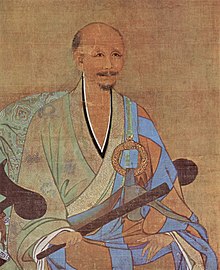Enni Ben'en
Enni Ben'en (also Enni Bennen ; Japanese 円 爾 弁 円 ( Shinjitai ) or 圓 爾 辯 圓 ( Kyūjitai ); * 1202 in the province of Suruga ; † 1280 at Tōfuku-ji ) was a Buddhist monk from Japan , the decisive He had a share in establishing Zen as a separate school in his home country by practicing a hybrid form between Zen and established Buddhist teachings, but giving Zen a priority.
His title , which was given to him posthumously by the Hanazono - tennō in 1312, is Shōichi Kokushi ( 聖 一 國 師 ), from which the name of the very successful tradition of Rinzai-shū founded by him , the Shōichi-ha ( 聖 一派 ), was derived.
Significant direct students of Ennis included a. Tōzan Tanshō (1231–1291), Mukan Gengo (or Mukan Fumon ; 1221–1291) and Hakuun Engyō (1228–1297)
The writings he left behind include his treatise on the Buddhist schools and the peculiarity of the Zen school Jushūyōdōki ("Essentials of the way of the ten schools") and the collection of sayings Shōichi goroku ("Analects of Shōichi").
Life
Enni came to Mount Kunō at the age of five, where he began studying Buddhist scriptures at the age of eight under the guidance of the Tendai monk Gyōben . At the age of 18 he entered the Mii-dera as a monk, his ordination with the acceptance of the Silas took place in Tōdai-ji . He then studied for three years in Kyoto to Confucianism , after which he returned to the Mii-dera and finally in Choraku-ji settled where he student of Eichō (a disciple of Eisai was). This was followed by a study of Tendai esotericism ( 台 密 , taimitsu ) on Mount Kunō near Kenzei (1224), which he completed in Jufuku-ji under A'nin (1228).

In 1235 Enni went on a trip to China . There he became a student of Wuzhun Shifan ( Chinese 無 準 師範 , Pinyin Wúzhǔn Shīfàn , W.-G. Wu-chun Shih-fan ; Japanese Bujun Shipan or Bushun Shihan ; 1177-1249), a Chan master from the Yangqi lineage ( Chinese 楊 岐 , Pinyin Yángqí , W.-G. Yang-ch'i ; Japanese Yōgi ) the Linji zong ( Chinese 臨濟 宗 , Pinyin Línjì zōng , W.-G. Lin-chi tsung ), the in one Temple on Mount Jing ( Chinese 徑山 , Pinyin Jìng shān , W.-G. Ching-shan ) in Zhejiang Province . In 1237 Enni received the seal of enlightenment ( 印 可 , inka ) from Wuzhun and became his Dharma successor .
After his return to Kyushu in 1241, Enni founded several monasteries near Hakata and preached at the temples of Sōfuku-ji , Manju-ji and Shōten-ji . As early as 1243 Fujiwara Michiie ( 藤原 道家 ; 1192–1252) was his patron, began building what would later become Tōfuku-ji, and saw Enni as its founding chief. In addition to Zen, Tendai and Shingon rites should also be held at the temple . It was inaugurated in 1255 by Enni, who until then had stayed in Fumon'in, a side temple of the still unfinished main temple. Later Enni also took over the office of head of the Kennin-ji . Kyōto soon became the center of early Zen in Japan. From 1257 Enni also worked on the Jufuku-ji in Kamakura .
literature
- Heinrich Dumoulin : History of Zen Buddhism. Volume II: Japan . Francke-Verlag, Bern 1986. ISBN 3-317-01596-9 .
- Daigan Lee Matsunaga and Alicia Orloff Matsunaga: Foundation of Japanese Buddhism; Vol. II; The mass movement (Kamakura & Muromachi periods) . Buddhist Books International, Los Angeles and Tokyo 1976. ISBN 0-914910-27-2 .
Individual evidence
- ↑ Dumoulin 1986, p. 24 f.
- ↑ Dumoulin 1986, p. 468.
- ↑ Dumoulin 1986, p. 23.
- ↑ a b Dumoulin 1986, p. 20 f.
- ↑ Matsunaga 1976, p. 217.
- ↑ Dumoulin 1986, p. 22 f.
| personal data | |
|---|---|
| SURNAME | Enni Ben'en |
| ALTERNATIVE NAMES | Enni Bennen; 円 爾 弁 円 (Japanese, Shinjitai); 圓 爾 辯 圓 (Japanese, Kyūjitai) |
| BRIEF DESCRIPTION | buddhist japanese monk |
| DATE OF BIRTH | 1202 |
| PLACE OF BIRTH | Suruga Province |
| DATE OF DEATH | 1280 |
| Place of death | at Tofuku-ji |